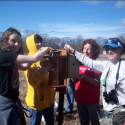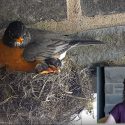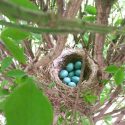 Photo ©
Keith Williams
Photo ©
Keith Williams

New Pocket Guides Available
It’s that time of year when NestWatch starts receiving hundreds of requests for nest identification as well as common questions about nest box management. We are thrilled to announce that two new guides are available to help address the information needs of our community!
Check out our new Nests and Eggs guide, and the Right Bird, Right House guide, both part of an exciting new series of All About Birds Pocket Guides, available from Waterford Press and the Cornell Lab Publishing Group. These lightweight, portable guides are ideal for bird lovers, classrooms, and nature centers looking to enhance the spring nesting season experience.
To celebrate, we’re giving away a copy of Nests and Eggs and Right Bird, Right House to three lucky NestWatchers! To enter, simply reply to our post on Facebook sharing a memorable NestWatching moment (photos encouraged but not required). The contest ends May 31 and winners will be notified via direct message on Facebook.
Can’t wait? Order your guides today. Other available titles include Birding 101, Gardening for Birds, and Bird Feeders and Food.

New Jersey High Schoolers Do Science
This year marks the 25th year that students and alumni volunteers from Red Bank Catholic High School in Red Bank, New Jersey, have been monitoring nesting birds. Under the direction of AP biology teacher Mary Jane Davis, students have been designing and constructing nest boxes from both wood and PVC and installing them in Dorbrook Park. Each year, the students gather data and submit it to NestWatch.
Now in its third decade, the program has contributed more than 380 nest attempts from 51 nest boxes (39 boxes are still in use). The top three species monitored are Tree Swallow, House Wren, and Eastern Bluebird. “Students have been involved since the beginning, and many continue to participate as alumni,” Davis said.
The Cornell Lab of Ornithology has frequently seen that participating in authentic, meaningful citizen-science projects can have a lifelong impact on young learners. The leadership of teachers like Mary Jane Davis, who began the nest box trail in 1993, is critical to introducing STEM concepts and civic engagement to young people. In this case, the students have access to their very own long-term study system and data set.
Please join us in thanking Red Bank Catholic High School, and the many other schools that are participating in NestWatch. Mary Jane and her entire class have been given access to one of our most popular Bird Academy online courses for free as a “thank you” for their good efforts.

Robyn Talks Robins
Our friends at Bird Cams have been live-streaming from an American Robin nest at the Cornell Lab of Ornithology (nest fledged on May 21). NestWatch project leader Robyn Bailey recently sat down with Bird Cams viewers to discuss the nesting habits of robins and why it’s important to monitor even common backyard birds.
In case you missed it, the hour-long webcast is archived online. Learn all about American Robins, and don’t forget to report your nesting robins to NestWatch. If you missed the robin cam, don’t worry; there are still plenty of opportunities to watch birds nest, court, and feed on Bird Cams.

Common Birds & Extraordinary Finds!
Check out our Participant Photo Gallery for a glimpse into the lives of breeding birds around North America. See familiar birds like chickadees and bluebirds, as well as rarities and odd behaviors.
American Robin nests are a common sight, but a robin nest with eight eggs?! Robin clutches max out at five eggs, so it is likely that a second female laid eggs in the nest. Elizabeth Arnold of Attleboro, Massachusetts, is monitoring the nest and updating the gallery with photos. How many eggs will hatch? Stay tuned to find out.
Another recent addition to the gallery is a highly-camouflaged Chuck-will’s-widow photographed by Steven Weiss in New Jersey. Can you see her incubating eggs on the forest floor?
Our Great Crested Flycatcher Project continues to draw photos, like this flycatcher wielding a large snakeskin photographed by Bonnie Smith of Louisville, Georgia.
New photos are added daily! Submit your own shots and join the fun.
New Mobile App FAQ Page
New for May, we now have an FAQ section about using our mobile app. From setup through data entry, we’ve gathered the most common questions into one helpful resource. Check it out. Still have questions? Contact us.